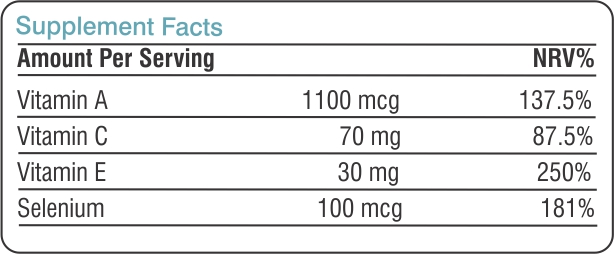

Product information
An antioxidant is a molecule that inhibits the oxidation of other molecules. Oxidation is a chemical reaction that can produce free radicals, leading to chain reactions that may damage cells(1).
Antioxidants may play a role in the management or prevention of some medical conditions, such as some cancers, macular degeneration, Alzheimer's disease and arthritis-related conditions(2).
Free radicals are highly unstable molecules that are naturally formed when you exercise and when your body converts food into energy. Your body can also be exposed to free radicals from a variety of environmental sources, such as cigarette smoke, air pollution, and sunlight. Free radicals can cause “oxidative stress,” a process that can trigger cell damage.
Oxidative stress is thought to play a role in a variety of diseases including cancer, cardiovascular diseases, diabetes, Alzheimer’s disease, Parkinson’s disease and eye diseases such as cataracts and age-related macular degeneration(3).
Free radicals derived from oxygen, nitrogen and sulphur molecules in the biological system are highly active to react with other molecules due to their unpaired electrons. These radicals are produced during cellular metabolism and functional activities and have important roles in cell signalling, apoptosis, gene expression and ion transportation. Excessive radicals attack nucleic acids bases, amino acid side chains in proteins and double bonds in unsaturated fatty acids and cause oxidative stress, which can damage DNA, RNA, proteins and lipids. Antioxidants can decrease the oxidative damage directly via reacting with free radicals or indirectly by inhibiting the activity or expression of free radical generating enzymes and enhancing the activity or expression of intracellular antioxidant enzymes(4).
Vitamin A- Vitamin A helps in regulating immune function and to reduce morbidity of infectious diseases. It is required for normal functioning of the visual system, maintenance of cell function for growth, epithelial integrity and production of red blood cells, immunity and reproduction(5).
Vitamin A / retinol are involved in the production, growth and differentiation of red cells, lymph cells and antibodies. Because of its proven effectiveness in protecting against measles-associated pneumonia (5).
Vitamin A intervenes in speed recovery; reduce the severity of acute lower respiratory tract infections(6).
Vitamin C (ascorbic acid) is for the prevention or relief of common cold. Ascorbic acid effectively prevents/ ameliorates common cold. Ascorbic acid plays a critical role in wound repair and healing/regeneration process as it stimulates collagen synthesis. Vitamin C protects against oxidation of isolated LDL by different types of oxidative stress and modification, lipid peroxidation of low density lipoproteins (LDL) are implicated in development of atherosclerosis(7).
Vitamin E, a potent peroxyl radical scavenger, is a chain-breaking antioxidant that prevents the propagation of free radical damage in biological membranes(8).
The role of vitamin E in cellular signalling, vitamin E prevents loss of spermatogenesis in males(9).
Selenium has been explored in normal thyroid functioning, enhancing immune function, carcinogenesis and cardiovascular diseases, in the prevention of pre-eclampsia, diabetes mellitus and male reproduction (10).
References:
1.Antioxidant, en.wikipedia.org/wiki/Antioxidant#cite_note-1
2.www.webmd.com/food-recipes/antioxidants-topic-overview
3.nccih.nih.gov/health/antioxidants/introduction.htm
4.Chemical and molecular mechanisms of antioxidants: experimental approaches and model systems, J Cell Mol Med. 2010 Apr; 14(4): 840–860.
Published online 2009 Sep 14.doi:10.1111/j.1582-4934.2009.00897
5.Vitamin A supplements for preventing mortality, illnessand blindness in children aged under 5, systematic review and meta-analysis BMJ 2011;343 doi:dx.doi.org/ 10.1136/bmj. d5094 (Published 25 August 2011)Cite this as: BMJ 2011;343:d5094
6Vitamin A supplementation to improve treatment outcomes among children diagnosed with respiratory infections, www.who.int/elena/titles/bbc/ vitamin a_ pneumonia_ children/en/
7.Vitamin C in human health and disease is still a mystery? An overview
8.Vitamin E: beyond antioxidant function, ajcn.nutrition.org/ content/62/6/ 1501S.abstract
9.Vitamin E: function and metabolism, July 1999The FASEB Journal vol. 13 no. 10 1145-1155
10.Selenium in human health and disease: a review, www.jpmi.org.pk/ index.php/jpmi/ article/view /1262
